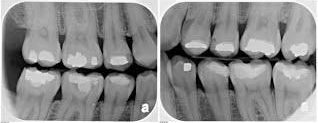Dental professionals today are increasingly using digital x-rays to better detect, diagnose and monitor oral conditions and diseases. Digital radiography is an imaging technique which uses digital x-ray sensors to replace traditional photographic x-ray film, producing enhanced computer images of structures in the mouth.
Digital radiographs can be viewed instantly on a computer screen and manipulated to enhance contrast and detail. Most importantly, digital sensors are more sensitive to x-ray radiation than traditional film, resulting in 80 percent less radiation compared to traditional film x-rays.
Periapical (PA) X-ray
A periapical (PA) x-ray refers to a single tooth x-ray taken to focus on a specific area of concern. If you have a toothache, your dentist is likely to order a PA film to see the whole tooth and its roots.
Bitewings
Bitewings help diagnose gum disease and cavities between teeth. The bitewing X-ray is placed on the lingual (tongue) side of your teeth and is held in place by biting down on a plastic tab. Normally four bitewings are taken as a set. They may be repeated every six months for patients prone to cavities and every few years for others with good oral hygiene and no cavities.
Panoramic X-rays as a Screening Tool
Panoramic x-rays, also known as full mouth x-rays or OPGs, are an important part of a comprehensive dental examination. They allow your dentist to see all your teeth, their surrounding tissue and the jaw bones in one single image. Dental experts recommend full mouth x-rays for all new patients. This will allow the dentist to screen for any hidden problems such as deep-seated tooth infections, cavities between tightly spaced teeth, impacted wisdom teeth and their complications, bone cysts, tumours and others. The full mouth x-ray serves as a baseline, enabling the dentist to identify changes that may occur later. If you have taken recent x-rays with another dental practice, ask for copies to be sent to your attending dentist. Such x-rays are recommended bi-yearly depending on your present oral health, age, risk for disease and any signs and symptoms of oral disease.
Panoramic X-rays for Treatment Planning
Braces
An x-ray is the most accurate way to help orthodontists find the best plan to correctly align the teeth and jaws through braces, Invisalign or other means of treatment. The braces specialist uses the panoramic x-ray to see the number of baby teeth and permanent teeth, look at tooth alignment, jaw alignment and the roots of all teeth. During braces treatment, the orthodontist will do further panoramic x-rays to visualise the roots of the teeth. Based on your progress, your orthodontist can determine if your treatment plan is working or if it needs to be altered.
Dental Surgery
Panoramic x-rays allow dentists to study the position and alignment of your wisdom teeth, their proximity to crucial nerves and their effects on the neighbouring teeth and bones. This is crucial in the planning of safe wisdom tooth surgery. They are also regarded as the most basic imaging tool required to guide dental implant placement.
Discuss with your dentist if you have any concerns with taking x-rays. Early detection and treatment of dental problems can save you time, money and discomfort in the long run.
